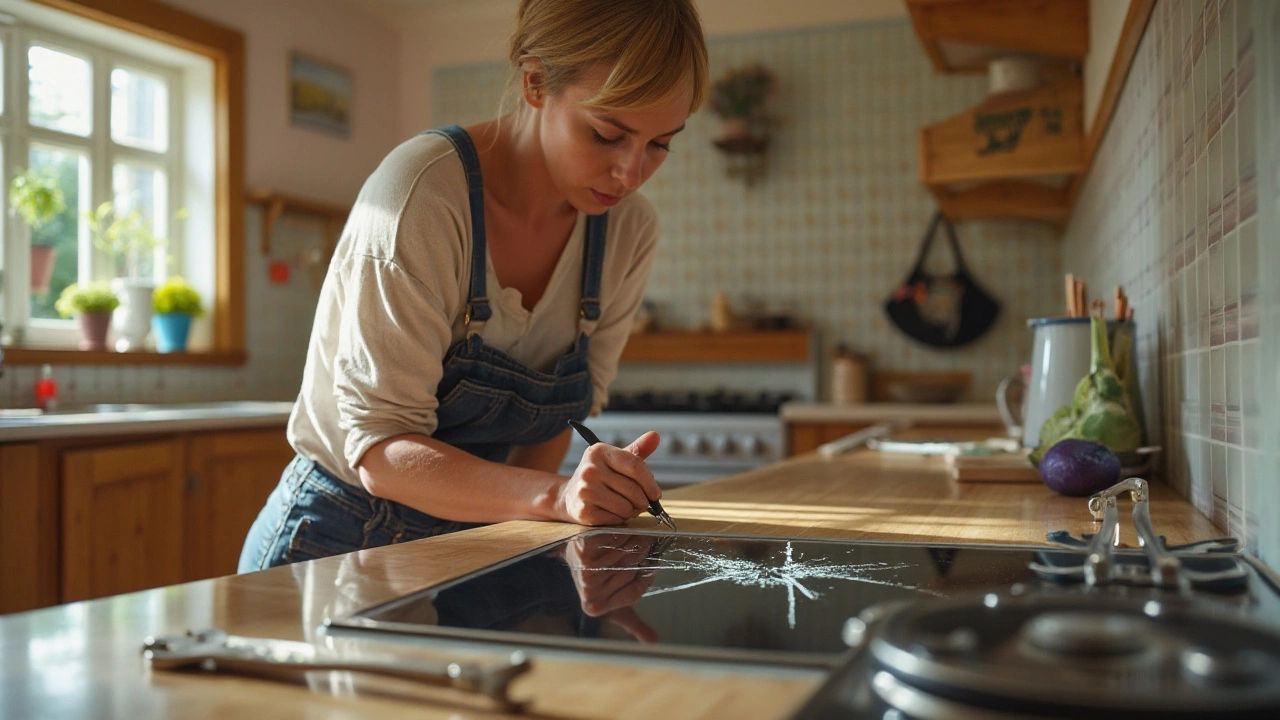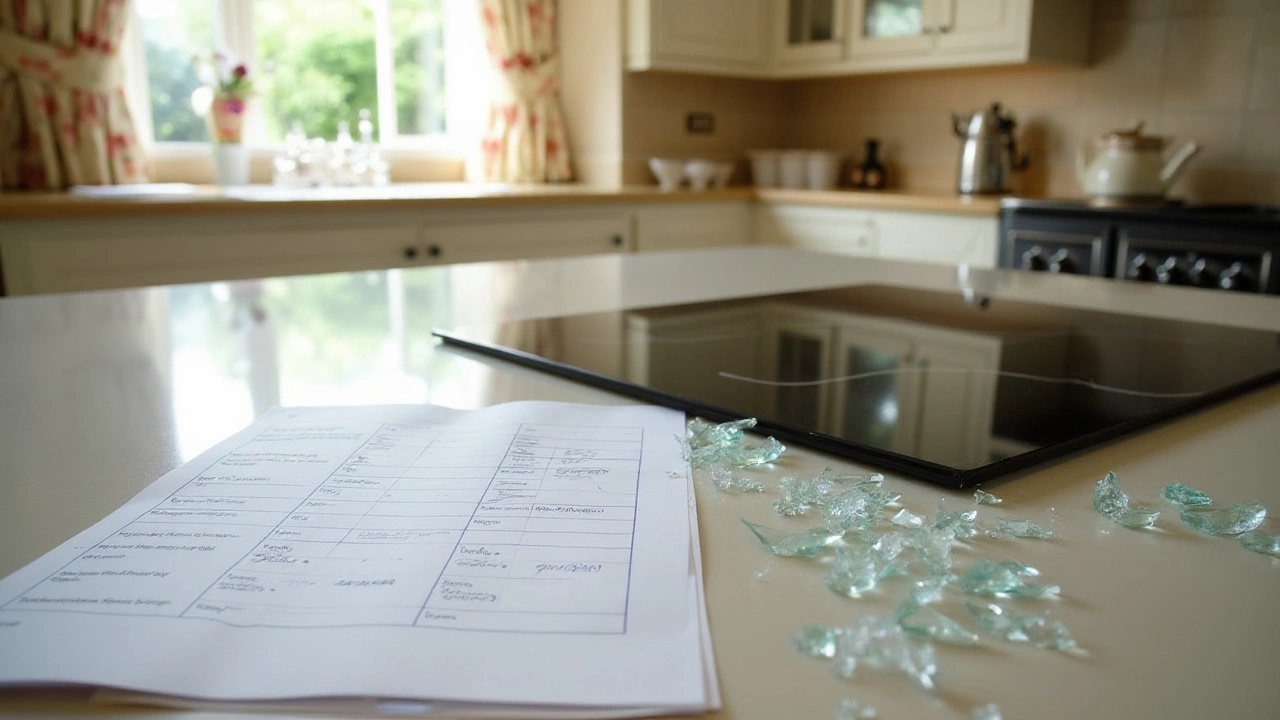If you've ever encountered a cracked or shattered glass hob, you know the mix of frustration and urgency that follows. A glass hob not only complements your kitchen decor but also provides a smooth surface for cooking your favorite meals. However, damage can occur unexpectedly due to impacts, thermal shock, or everyday wear and tear.
This comprehensive guide dives into the nitty-gritty of what it takes to repair a glass hob, balancing the scales between cost-effectiveness and functionality. Whether you're weighing the DIY route or considering professional intervention, we offer key insights and practical tips to aid your decision-making process. Our aim is to help you navigate this kitchen conundrum with ease, keeping your cooking hub pristine and efficient.
- Understanding Glass Hob Damage
- Cost Factors to Consider
- Repair or Replace?
- DIY Repairs vs. Professional Help
- Cost-Saving Tips
- How to Prevent Future Damage
Understanding Glass Hob Damage
Picture this: you're preparing dinner, and suddenly there's a startling crackling sound. Your once pristine glass hob now has an unsightly split running across its surface. The fragility of glass hobs makes them susceptible to various types of damage, and understanding these nuances is crucial. Glass hobs, often made from toughened glass, are designed to withstand heat and pressure in everyday cooking scenarios. However, they are not immune to impact from heavy cookware or abrupt temperature changes that can lead to thermal shock.
The most common types of damage include cracks, scratches, and chips. Cracks often result from heavy objects accidentally falling onto the surface or uneven heating. While small scratches can occur from dragging pots across the surface, they generally don't affect the hob's functionality but can be unsightly. Chips typically occur at the edges where the glass is most vulnerable. The structural integrity of a glass stove top can also be compromised if the crack penetrates through its layers.
Interestingly, the evolution of glass hob design has led to innovative temperature-resistant materials, yet, improper use and external conditions remain threats. A report by the Consumer Product Safety Commission revealed a notable number of kitchen incidents involving glass cooktops shattering unexpectedly. This underscores the need for awareness and caution.
"The durability of glass hobs is commendable, but users must handle them with care, just like any other glass product in the kitchen," suggests John Darbyshire, a noted kitchen appliance safety consultant.Recognizing the early signs of damage allows for prompt repair, potentially saving you from more expensive fixes down the line.
Another critical aspect to consider is how the damage might affect your hob's efficiency. A compromised glass surface can lead to uneven heat distribution, impacting the quality of your culinary creations. Delving deeper, we find that thermal shock is a significant enemy of glass hobs. This phenomenon occurs when there's a sudden temperature change; for instance, placing a cold pan on a hot surface or vice versa. It emphasizes the importance of proper use and maintenance to ensure a long-lasting, functional surface. These insights form a solid foundation before contemplating the repair or replacement of your precious appliance.
Cost Factors to Consider
Delving into the financials of repairing a glass hob reveals a complex web of considerations that can influence the price you'll pay. First and foremost, the extent of the damage plays a critical role. A minor chip or crack might be straightforward and inexpensive to fix, possibly involving the application of a special adhesive or filler designed to mend small defects. However, a shattered hob or extensive cracking often mandates a complete replacement of the glass surface, which obviously incurs higher costs due to the materials and labor involved.
Another pivotal cost determinant is the type and model of your hob. High-end brands or models featuring unique designs or custom dimensions often entail greater repair costs simply due to the scarcity and price of their replacement parts. Conversely, more common or standardized models may offer a more budget-friendly repair approach thanks to the wider availability and affordability of parts.
The availability of the needed components also affects the price. Some models may require parts that have become obsolete or are manufactured by limited suppliers, driving up the cost. In such cases, repair jobs can be delayed, too, as technicians wait for these specialized components to arrive. Hence, it can be beneficial to research whether your appliance's parts are readily available before committing to the repair. As one experienced repair technician once noted in a trade magazine:
"The quicker you can source parts, the sooner—and often cheaper—you can expect the repair to be."
Labor and expertise are no small factors either. If your chosen repair professional commands a higher fee, possibly due to their extensive expertise or the prestigious reputation of the company, expect that to reflect in the final bill. However, the trade-off might be faster service and a more secure repair, which could save money on future problems down the line.
There are potential hidden costs, too. For instance, if your hob requires transportation to and from a service center, those logistical expenses can add up quickly. Some specialists offer on-site repair services that might mitigate these extra costs, but it's vital to confirm this availability and any associated fees upfront.
We mustn't overlook geographical variance either, as location can contribute to differing repair costs. Urban centers might boast higher prices due to elevated operational costs. Meanwhile, rural areas might present challenges in sourcing skilled technicians, inadvertently hiking the cost due to travel charges or the scarcity of service options.

Repair or Replace?
When faced with a damaged glass hob, deciding whether to repair or replace it can be a daunting task. This decision largely hinges on the extent of the damage and the cost implications involved. Not all cracks are created equal, and the severity can vary from minor scratches to full-blown shatters. A small crack might seem insignificant, but it can quickly grow into a bigger problem if not addressed promptly. It's crucial to assess the damage accurately before making a decision. On one hand, a straightforward repair might suffice if the damage is minimal and limited to a single, isolated section of the glass. On the other hand, a serious crack that compromises the structural integrity or the safety of the hob often necessitates a replacement.
The cost of repairs can vary widely based on several factors. Simple repairs for minor cracks might only set you back a few hundred dollars, whereas more extensive damage could escalate the price significantly. The availability of replacement parts and the brand of the hob also play vital roles in determining repair costs. In some instances, finding parts for older models can be challenging, thus pushing you towards considering a full replacement instead. Importantly, the decision should also factor in the age of the hob. If your hob is nearing the end of its lifespan, a new purchase might provide you better value in the long run. Given the rapid advancement in kitchen technology, newer models might offer energy savings and improved functionality that your older hob lacks.
"Replacing an aging appliance with an energy-efficient model can significantly reduce utility bills and enhance cooking experiences," notes Consumer Reports.
Repairing might seem like the more affordable option initially, but it's worth considering potential future expenses. For instance, if a repair fails to restore the hob to its optimal functionality or if it leads to frequent issues, the costs can pile up over time. Investing in a new appliance could save you the hassle and costs of repeated repairs. When weighing these options, it’s beneficial to invest time in researching and comparing prices of repair versus replacement. Some manufacturers or retailers offer exchange programs or discounts on new purchases for customers trading in their old appliances. Exploring such opportunities could further ease the financial burden. Ultimately, prioritizing safety and functionality should take precedence over cost alone in making the final decision.
DIY Repairs vs. Professional Help
When it comes to repairing a glass hob, the first decision most homeowners face is whether to embark on a do-it-yourself journey or to seek the expertise of a professional. Understanding the benefits and drawbacks of each option can greatly influence the outcome of the repair. DIY repairs may initially appear enticing due to the potential for cost savings. Equipped with a repair kit and a little determination, numerous folks have successfully tackled minor glass hob damages. Such kits are readily available in many stores, providing tools and sealants to fix small cracks or chips. However, it's crucial to consider the nature and severity of the damage. A DIY repair might suffice for a superficial scratch or chip, but more extensive damage, like a full-blown crack, likely needs professional attention. An improperly executed repair could lead to further damage or, worse, safety hazards such as electrical shorts or gas leaks.
There's often a sense of accomplishment and newfound skills gained from attempting a repair yourself. For those experienced in home improvements, DIY can be an empowering endeavor. However, not all issues are created equal, and a failed DIY attempt can escalate the overall repair cost if further harm is done, ultimately necessitating professional intervention anyway. In contrast, professional hob repair services come equipped with expertise and tools that the average homeowner might lack. These technicians bring years of experience to the table, capable of accurately diagnosing problems and implementing solutions that are both effective and long-lasting. Engaging a professional from the get-go can provide peace of mind, ensuring that your kitchen returns to full functionality without the risk of botched repairs.
If cost is a major concern, it's worth exploring service warranties or insurance coverage, which might offset some professional service costs. Many repair businesses offer a guarantee on their work, providing an added safety net. According to a recent survey, around 60% of homeowners preferred hiring experts for appliance repairs primarily because of the safety and reliability involved.
"Hiring a professional can mitigate risks and ensure compliance with safety standards, not commonly understood by the average DIY enthusiast," Josh Wyman, an appliance repair consultant, observes.The balance between attempting a DIY repair and hiring a professional should factor in your level of technical skill, the complexity of the damage, and the costs involved. Ultimately, the aim is to make an informed choice that satisfies both your budget and safety concerns while maximizing the lifespan of your glass hob.

Cost-Saving Tips
Fixing a glass hob can indeed be costly, especially when unexpected. However, there are several methods to keep expenses in check while ensuring the repair is long-lasting and effective. Consider these strategies as you navigate through potential savings and budgeting for your kitchen maintenance.
One practical strategy involves sourcing parts independently. Many professionals might charge a premium for parts alongside their labor costs. By researching and purchasing the appropriate parts yourself, you can cut down on unnecessary markups. Websites and marketplaces specifically for appliance parts often offer competitive prices and detailed product descriptions. This gives you the financial flexibility to address repair costs without straining your wallet.
Comparing quotes from various repair services is another effective way to save. It's easy to default to the first available service when your hob needs attention, but taking the time to solicit multiple quotes ensures you get the best deal. While comparing, pay close attention to what's included in the repair package. Some businesses might offer bundled services or discounts that can shave off substantial amounts from the total bill.
"Sourcing parts independently can cut repair costs by up to 30%, according to Home Appliance Journal."
The do-it-yourself approach is also something to ponder over. With an increasing number of internet resources, video tutorials, and forums dedicated to appliance repair, there's no shortage of information available for those willing to get their hands a bit dirty. However, always assess whether the damage is manageable for a DIY fix. For minor issues, tackling the repair yourself might save considerable fees you’d otherwise pay a professional.
Also, routine maintenance can reduce the frequency and severity of damage. Regular cleaning and cautious handling can prevent many common issues that lead to the need for glass hob repair in the first place. Taking simple steps like avoiding sudden impacts or extreme temperature changes and ensuring the hob is properly secured can shield you from frequent repair costs.
| DIY Repairs | Professional Repair |
|---|---|
| Lower initial cost | Warranties on service |
| Greater personal time investment | Experienced workmanship |
| Access to online resources | Assured part compatibility |
Lastly, consider whether the problem warrants a repair or an upgrade. While keeping a keen eye on savings is critical, sometimes investing in a new appliance, especially if yours is old or inefficient, could present long-term savings. Newer models might have better energy efficiency ratings, contributing to reduced utility bills and a much longer lifespan.
By incorporating these cost-saving strategies, you ensure that fixing your glass stove top doesn't become an overwhelming financial burden. Keeping informed and being proactive are key to managing and reducing those repair expenses effectively.
How to Prevent Future Damage
Maintaining the integrity of your glass hob is essential for both the aesthetics and function of your kitchen. A few simple practices can make all the difference in avoiding unwanted cracks and scratches. First and foremost, always use cookware that is suitable for glass surfaces. Heavy cast iron pots, while excellent for certain types of cooking, can cause significant damage if dropped or dragged across the smooth surface of your hob. Instead, consider using lighter materials that are easier to handle, and always lift your pots and pans instead of sliding them.
Temperature plays a pivotal role in preventing damage. Glass can be sensitive to sudden changes in heat, which can lead to thermal shock. This often happens when a cold pot is placed on a hot hob or vice versa. To mitigate this, allow your cookware to warm or cool slightly on the countertop before transitioning to the hob. Regularly ensure that the burners are not left on for extended periods without cookware, as this can also stress the glass.
Cleaning is another critical aspect to consider. It's easy to overlook small spills and splatters, but over time, these can bake onto the hob and become difficult to remove without harsh scraping that might scratch the glass. Use a soft cloth and specialized cleaning agents designed for glass surfaces. After cooking, let the hob cool completely, then gently remove any debris with a damp cloth followed by a dry wipe.
"Investing a little extra time in preventative care can save you from costly repairs down the road," says Joanna Martin, a home maintenance expert. "It's not just about the immediate cost, but preserving the overall value of your appliances."
If you notice minor scratches or stains developing, there are commercial products available that can help minimize their appearance. However, be cautious with these as frequent use can lead to unwanted residue build-up. To truly protect your glass hob from long-term damage, consider using a transparent cover when the hob is not in use. This adds a layer of protection while maintaining visibility in your kitchen’s aesthetic setup.
Lastly, be mindful of the connections and wiring that support your stovetop, especially on electric models. An unstable connection can lead to malfunction and potential harm to the glass surface. Regular inspections, perhaps every six months or annually, can ensure all electrical components are in good condition and secure. By integrating these practices, you can enjoy the sleek appearance and efficient cooking surface of your glass hob while extending its lifespan and reducing the likelihood of costly repairs.


